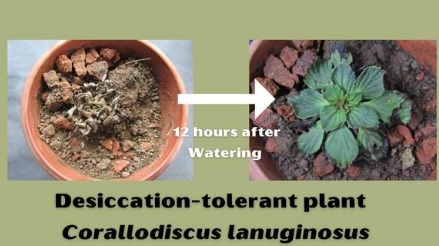Biodiversity & Environment
Desiccation-Tolerant Plant Species
- 20 Jul 2023
- 4 min read
For Prelims: Western Ghats Species, Hydration, Tropical rock outcrops
For Mains: How Desiccation-tolerant vascular (DT) plant species can be used to boost climate resilience agriculture and ensure mass food security.
Why in News?
New study discovers 62 desiccation-tolerant vascular plant species in India's Western Ghats, with potential applications in agriculture & conservation. These species of plants can withstand harsh environments.
- A recent study by scientists from Agharkar Research Institute (ARI) Pune, an autonomous institute of the Department of Science and Technology (DST), has identified 62 DT species in the Western Ghats, many more than the earlier known nine species.
What is DT Plant?
- Desiccation-tolerant vascular (DT) plants are able to tolerate the desiccation of their vegetative tissues. DT plants are the most common residents of tropical rock outcrops.
- DT plants can survive high dehydration, losing up to 95% of their water content.
- Dehydration in plants occurs when the plant loses more water than it takes in. A close-up of a plant
- Population:
- As per the study, the global population of these species’ ranges between 300 and 1,500.
- Out of the 62 species found, 16 are native to India and 12 are restricted to Western Ghats outcrops.
- As per the study, the global population of these species’ ranges between 300 and 1,500.
- Habitation:
- DT plants can be found in both tropical and temperate regions.
- They can quickly regenerate when water supplies are restored and are frequently found on rocky outcrops in the tropics.
- It is crucial for the world's warming that some species can thrive at higher temperatures.
- Hydration and desiccation resistance are two widely studied mechanisms for plants in harsh environments.
- Hydration is a situation in which plant tissues can withstand more than 30% water content.
- Indian desiccation tolerant plants are primarily found in forest rock outcrops and partially shaded tree trunks. Ferricretes (a hard, erosion-resistant layer of sedimentary rock) and basaltic plateaus (plateaus produced by volcanic activity) seemed to be the preferred habitats.
- Glyphochloa goaensis, Glyphochloa ratnagirica and Glyphochloa santapaui were found only on ferricretes (a hard, erosion-resistant layer of sedimentary rock), while the rest of the species were found in both ferricretes and basaltic (plateaus produced by volcanic activity) plateaus.
- The dominant genus was Glyphochloa, with mostly annual species occurring on plateaus.
- Characteristic:
- The DT species showed colour variations and morphological characteristics.
- Tripogon species changed colours from greyish in dry conditions to green in hydrated situations.
- In Oropetium thomaeum, the leaf cloud transformed from green to dark purple or orange in the hydrated phase and ranged from brownish to ash in the desiccation phase.
- Ferns (fronds) displayed a variety of characteristics, including curling inwards towards the costa, exposing spores at the start of the dry season and during brief dry spells.
- The DT species showed colour variations and morphological characteristics.
- This, however, was not true for all species. In the case of C lanuginosus, the leaves folded and shriveled inward to shield the chlorophyllous portion, avoiding direct sunlight exposure during the desiccation phase.
- Significance:
- Desiccation-resistant vascular plant genes can be used to develop a high temperature tolerant crop variety to boost climate resilience.
- The discovery of the desiccation-tolerant (DT) vascular plants has agricultural uses, particularly in locations where water is scarce.
- These plants' genes could be exploited to develop a high-temperature tolerant crop variety to boost climate resilience and ensure mass food security.
- Desiccation-resistant vascular plant genes can be used to develop a high temperature tolerant crop variety to boost climate resilience.








